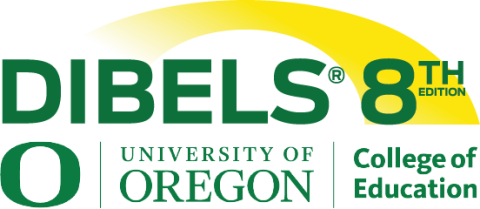
What is DIBELS?
DIBELS ® (Dynamic Indicators of Basic Early Literacy Skills) is a set of procedures and measures for assessing the acquisition of literacy skills. They are designed to be short (one minute) fluency measures that can be used to regularly detect risk and monitor the development of early literacy and early reading skills in kindergarten through eighth grade.
The measures are consistent with many of the Common Core State Standards in Reading, especially those for Foundational Skills. When implemented as recommended, DIBELS results can be used to evaluate individual student development as well as provide grade-level feedback toward validated instructional objectives.

Why Use DIBELS?
DIBELS 8th Edition is more useful for more students in more grades than ever before. DIBELS 8th Edition is the least invasive, and one of the most effective screening tools available. It is used widely in Title 1 schools across the nation, with students in special education programs and identified with specific learning disabilities like dyslexia, and by educators focused on improving literacy for all students. DIBELS was developed to measure recognized and empirically validated skills related to general reading outcomes. Each subtest has been thoroughly researched and demonstrated to be a reliable and valid indicator of early literacy development. Schools and districts choose DIBELS 8th Edition as their assessment solution, because they trust scientific evidence, research-based practices, and decades of experience in teaching and learning on which DIBELS is based.

DIBELS 8th Edition has a lot to offer that no other curriculum-based measurement (CBM) system ever has before. In fact, DIBELS 8th Edition is more useful for more students in more grades than ever before.
- Extended grade levels. DIBELS can be used from kindergarten through eighth grade.
- Consistent subtests within grade. Subtests relevant to a given grade are offered at every benchmark period.
- Enhanced composite scores. DIBELS composite scores has been overhauled to make them better than ever at predicting risk.
- New and revised subtests. DIBELS now includes word reading fluency and existing subtests have undergone extensive improvement efforts to maximize their usefulness.
- Expanding the safety net. DIBELS now offers a word reading fluency measure that can help to identify students with poor sight word and irregular word reading skills that other subtests miss. Maze is now offered for second grade, nonsense word fluency has been extended to third grade and includes advanced phonics patterns, and oral reading fluency and maze have been extended through eighth grade.
- Expanding the utility. DIBELS forms now have items that progress in difficulty beyond risk cut-points that provide data teachers can use in planning instruction for all students.
- Dyslexia screening. DIBELS subtests offer efficient and cost-effective measures of processing speed, phonological awareness, and the alphabetic principle for dyslexia screening purposes. For more information, read our Dyslexia Screening and DIBELS 8th Edition White Paper.
Where can I get DIBELS 8th Edition?
For your convenience we provide paper-based testing materials as a free download. Alternatively, DIBELS 8 Material Kits are available for purchase through our partners at Amplify. Amplify also offers the DIBELS Data System (DDS) and a mobile version of DIBELS 8th Edition on mCLASS.
2002
DIBELS 6th Edition
The first widely-available edition of DIBELS. Grades 4-6 added in 2007.
2010
DIBELS Next
DIBELS added measures of comprehension, including Maze.
2018
DIBELS 8th Edition
The most up-to-date and validated version of DIBELS. Many improvements, including extending through Grade 8.
DIBELS was developed based on Curriculum-Based Measurement (CBM), which were created by Deno and colleagues through the Institute for Research and Learning Disabilities at the University of Minnesota in the 1970s-80s (e.g., Deno and Mirkin, 1977; Deno, 1985; Deno and Fuchs, 1987; Shinn, 1989). Like CBM, DIBELS were developed to be economical and efficient indicators of a student's progress toward achieving a general outcome. Mark Shinn (Professor in the College of Education at the University of Oregon for 19 years) actually originated the name “Dynamic Indicators of Basic Skills” (Shinn, 1989, 1999).
Although DIBELS materials were initially developed to be linked to the local curriculum (Kaminski & Good, 1996), current DIBELS measures are generic and do not draw content from any specific curriculum. The use of generic CBM methodology is typically referred to as General Outcome Measurement (GOM) (Fuchs & Deno, 1994).
Research on DIBELS is conducted at the University of Oregon (UO) and began in the late 1980s. Since then, an ongoing series of studies on DIBELS has documented the reliability and validity of the various DIBELS subtests, as well as their sensitivity to student change. Research on DIBELS continues to this day at the UO's Center on Teaching and Learning (CTL) and has been conducted by dozens of UO faculty and students (e.g., Cummings, Park, & Bauer Schaper, 2013; Cummings, Stoolmiller, Baker, Fien, & Kame’enui, 2015; Smolkowski & Cummings, 2016; Stoolmiller, Biancarosa, & Fien, 2013).
